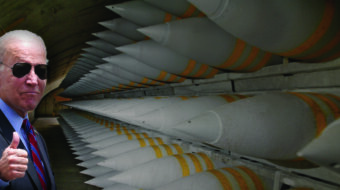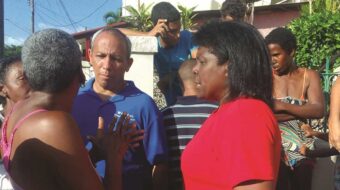
While troops of the government of President Petro Poroshenko push closer to Lubansk and Donetsk, and casualties rise in disaffected Eastern Ukraine, cracks are appearing in the coalition that brought the current government to power.
In February, protests in Kiev brought down the corrupt but legally elected government of President Victor Yanukovych. A special push arose from far right elements, which drove Yanukovych into exile. The far right forces, mostly from far Western Ukraine, were the Svoboda (“Freedom”) party and an alliance of other far right groups called the Right Sector, or Pravy Sektor. These groups were brought into the new government, headed by U.S. designate Arseny Yatsenyuk, some in key positions.
This led to a sharp reaction among Russian speakers in Eastern Ukraine. The ultra right elements brought into the Kiev alliance include admirers of Stepan Bandera. During World War II Bandera and his followers, after a period of friction, allied with Nazi Germany and committed atrocities against Poles, Jews and communists.
Once brought into government, these forces indicated that they would use their new power to push an extreme right wing nationalist agenda, including the downgrading of the status of the Russian language, the native tongue of over 40 percent of Ukrainian citizens. This alarmed people in far Eastern Ukraine, including the provinces of Lubansk and Donetsk, which border on Russia, Crimea, which is mostly ethnically Russian and hosts Russia’s Black Sea naval base, and Odessa. Opponents of the new regime seized power in the cities of Donetsk and Lubansk in April, declaring themselves to be “People’s Republics.” The same happened in Crimea, which was quickly annexed by Russia. On May 2, the fascist ultra right was blamed for an incident in which dozens of people were burned or beaten to death in the Trade Union Hall in Odessa.
The political tendencies that, starting in February have made up the governing coalition in Kiev are disparate in ideology and goals, sharing only the fact that they are right wing and want to suppress the Communist Party.
The Svoboda-Pravy Sektor forces are openly fascist and have a record of anti-Semitism. They are chauvinistically nationalist, anti-immigrant and anti-foreign. They have no use for “Europe.”
The elites around President Petro Porochenko, elected on May 25 in a fishy election, have other priorities. Poroshenko became a billionaire as Ukraine’s “Chocolate King.” His prime minister, Arseniy Yatsenyuk, now acting as caretaker prime minister after having presented his resignation last month, has a banking background. Several of the governors of Ukraine’s oblasts (provinces), who are appointed by the central government rather than elected, are also wealthy “oligarchs.” They are suspect in the eyes of both the ultra-right and, of course, the left. Furthermore, several people associated with the Poroshenko government are of Jewish origin, a fact which has been used by the Kiev regime’s apologists to prove that the Ukrainian right wing “can’t be” fascist.
The main reason this “oligarch” faction supported the Kiev protests was that in November of 2013, President Yanukovych had turned away from a prospective deal with the European Union which they supported and instead reoriented his policy toward a different and more generous deal offered by Russian President Vladimir Putin.
The goal of the Poroshenko government and the oligarchs is to quickly integrate Ukraine into the institutions of the European Union and NATO. Most people in Eastern Ukraine, however, feel closer to Russia than they do to Western Europe, and the more industrialized economy of the East is closely tied to the Russian markets.
But Poroshenko has needed the Svoboda-Right Sector elements. When, in the spring, Kiev sent troops to crush the insurgency in the East, many of them were captured or defected to the Donetsk and Luhansk forces. Poroshenko found it necessary to use the services of Right Sector’s armed militias to spearhead his attacks on Donetsk and Lubansk. This is bearing fruit: After relentless air and artillery strikes which have caused hundreds of civilian casualties, Kiev claims it is close to capturing both cities, though local militias are grimly holding on.
Right Sektor’s Azov battalion claims to have played a key role in this.
But now cracks are appearing in this reactionary marriage of convenience. On Monday, Right Sektor’s leader Dimitro Yarosh published a letter to the Kiev government in which he demanded that Interior Minister Arsen Avakov and President Poroshenko fire Deputy Interior Minister General Vladimir Yevdokimov whom Right Sektor accuses of being the head of “a criminal police group of separatist stooges and a Moscow puppet.” Yarosh also demanded that Right Sector members currently jailed be freed and their weapons be returned. If not, Yarosh says, Right Sector will pull its troops out of the fighting in the East and “March on Kiev.” Avakov appears to be giving in to Yarosh’s demands, having already taken steps to remove Yevdokimov.
It appears certain that if Lubansk and Donetsk fall, the thieves in Kiev will fall upon each other.
Photo: A local woman stands on her damaged balcony after morning shelling in a northern Donetsk neighborhood, eastern Ukraine, Aug. 9. Sergei Grits/AP












Comments